Traditional Hot Cross Buns
This post may contain affiliate links. See my disclosure policy.
The world famous sweet yeasted buns enjoyed throughout the Easter holidays or all year long, these Hot Cross Buns are packed with flavor and all of the charm of their rich centuries-old history! This traditional hot cross buns recipe will ensure your success and I’m confident it will become your go-to from now on!

Hot cross buns fill me with nostalgia. I lived 7 wonderful years in England and during Easter time I always looked forward to freshly baked hot cross buns at the local bakeries. Lightly spiced and pillowy soft with sweet chewy currants, these are one my favorite traditional British bakes. I’m confident you’re going to fall in love with them too!
What are Hot Cross Buns?
Hot cross buns are a sweet, yeasted buns made with currants or raisins, candied orange peel, and mixed spices. They are marked with a cross shape on top representing Christ’s crucifixion and are traditionally eaten on Good Friday and during the Easter holidays.
History of Hot Cross Buns
The concept of sweetened buns inlaid or decorated with religious symbols goes back to ancient times with the Egyptians, the Greeks, and later the Romans. In fact the English word “bun” is a derivative of the Greek word “boun” which referred to breads and cakes used for ceremonial purposes. The Christian adaptation of these buns, which would later become known as Hot Cross Buns, originated in England in the 14th century (likely introduced much earlier by the Romans) and have been associated with the Easter holiday ever since.
The precursor of the hot cross bun was the Alban Bun, developed by a 14th century monk, Brother Thomas Rocliffe, at St. Albans Abbey in Hertfordshire, an hour and a half directly south of where I lived outside of Peterborough. In 1361 he created a sweet yeasted bun with a cross cut into the dough on the top and distributed the buns to the poor on Good Friday. Though no longer available for free, these buns are still made and sold every Easter at the cathedral in the Abbot’s Kitchen where you can enjoy them freshly baked to go or you can sit down with a cup of tea. The recipe remains a carefully guarded secret but includes flour, eggs, yeast, dried currants, and cardamom (earlier versions likely included a spice from the ginger family known as grains of paradise). The recipients of the Alban Buns enjoyed them so much that word began to spread and soon other areas of the country worked to imitate the buns.

One such imitation was the hot cross bun and it featured a few differences: it included additional fruit such as candied citrus peel, additional spices, and instead of a cross cut into the dough, a cross made from extra dough was laid across the tops before baking, and then brushed with a glaze. While we don’t know exactly when hot cross buns first surfaced, the first official record we have of them is from a London street cry that was published in a 1733 edition of Poor Robin’s Almanac: “Good Friday comes this month, the old woman runs. With one or two a penny hot cross buns!” By the 1800’s, hot cross buns were well established and traditionally eaten on Good Friday to mark the end of Lent. While Alban Buns can only be purchased in St. Albans, hot cross buns can be purchased throughout the UK and in many parts of the world.
Hot cross buns are still traditionally enjoyed at Easter time but are available all year long in the UK. Each bun is decorated with a cross, representing Christ’s crucifixion, and made with spices, representing the spices used to embalm Christ.
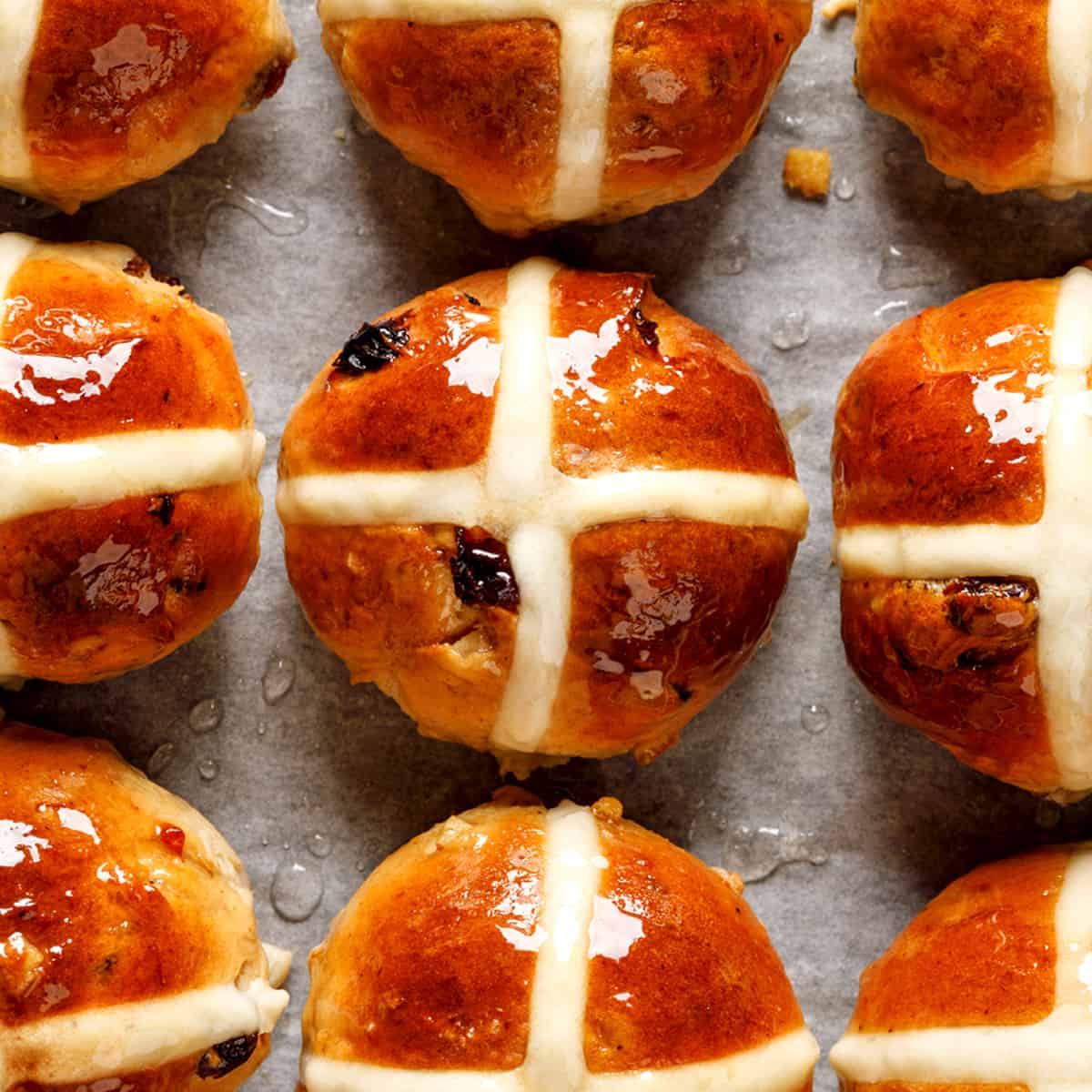
Hot Cross Buns Recipe
Let’s get started!
I like to soak the fruits first so that they’re plump and juicy. I like to follow the Welsh and Irish tradition of soaking the fruits in black tea (see Bara Brith and Barmbrack) but you can use apple juice instead or, if you prefer a strong flavor, you can use rum.
Pour the hot tea or apple juice over the dried fruits, cover with plastic wrap, and let sit for about an hour until the fruit has absorbed the juices. This can be done well in advance such as the day ahead or overnight. Note: While not traditional, if you like you can also include some Candied Ginger.
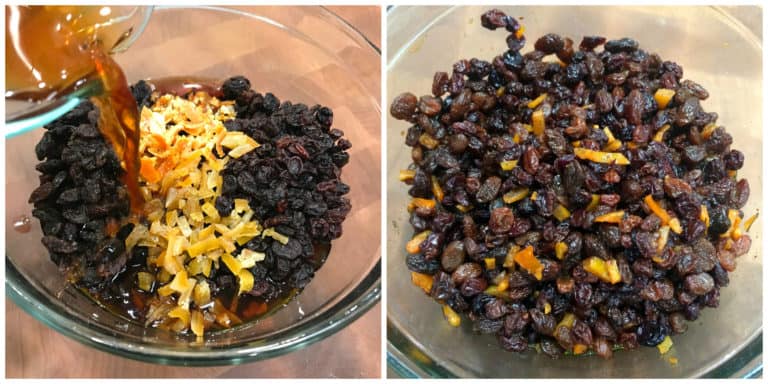
Place the flour, sugar, yeast, salt and spices in the bowl of a stand mixer and stir to combine.
Add the eggs, butter, and milk.
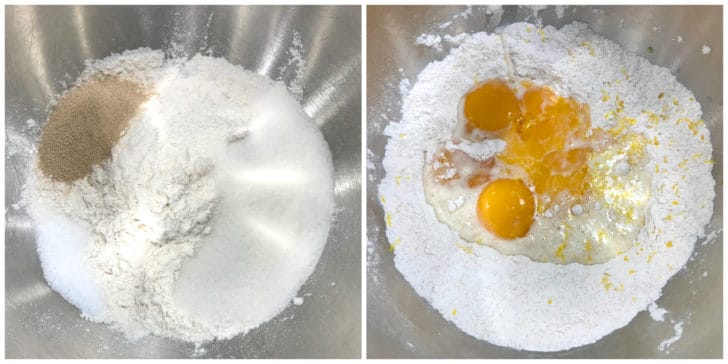
Use the dough hook to knead the mixture into a smooth and elastic dough, about 5 minutes.
Add the dried fruit and continue to knead the dough another 2 minutes or two until the fruit is incorporated.
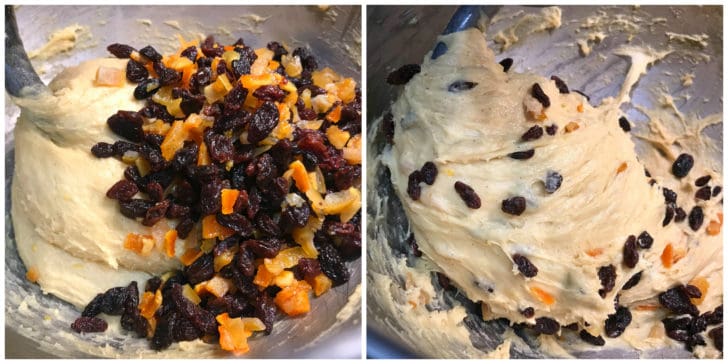
Place the dough in a lightly greased bowl, cover loosely with plastic wrap and place it in a warm place to rise until doubled in size. I like to briefly heat the oven to 80-90 degrees F (not any hotter!), place the dough inside the oven, and close the door to rise.
Rising time will vary depending on the temperature. Give it at least one hour but it might take closer to 2 hours.
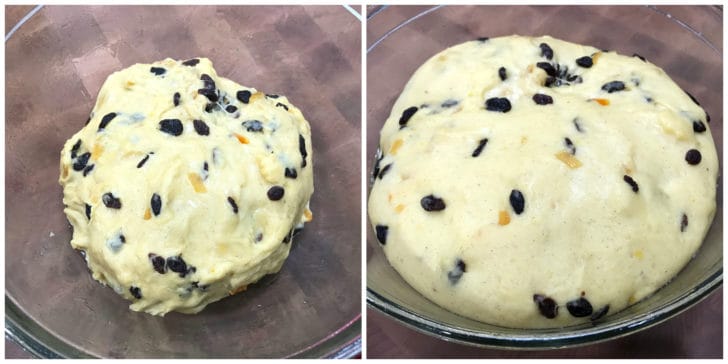
Punch down the dough and divide it into 12 equal pieces. Form each piece into a ball and place it on a lined baking sheet. Cover loosely with plastic wrap and let them rise in a warm place for up to another hour until they’re puffy and nearly doubled in size.
Halfway into the rise preheat the oven to 400 degrees F.
Baking Options
You can either place the buns closer together on the baking sheet so that once they’re baked you’ll need to pull them apart to separate them from each other and they will be more square-shaped. This is how they often come packaged in the store. Or you can space them farther apart so that you have distinctly separate and round buns (my personal preference).
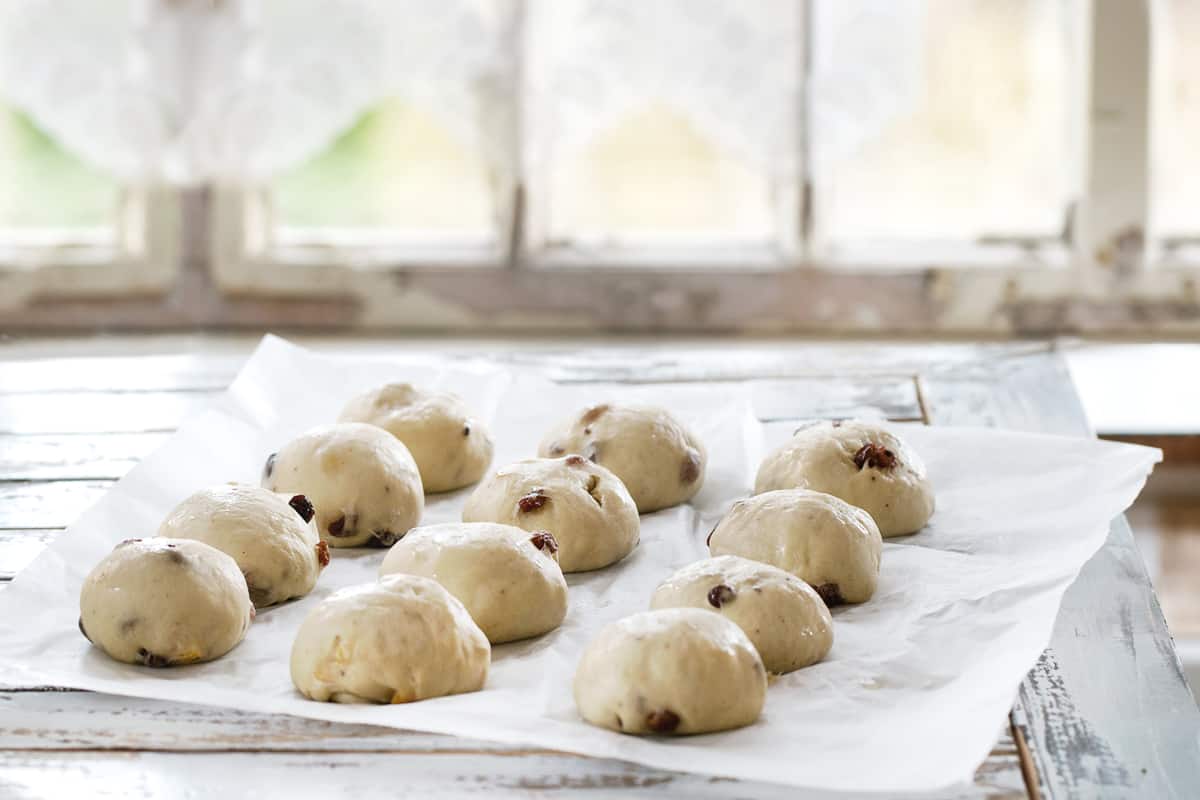
The next step is to pipe or place crosses on top of each bun and there are a few options for doing this.
Piping Options
You have a few options for making the cross symbol on top: 1) Make a small batch of shortcrust pastry (follow this recipe for the shortcrust pastry), form it into thin strips and lay them in a cross pattern on top of the buns before baking. 2) Make a paste out of flour and water and pipe crosses on the buns (combine 1/4 cup flour with about 3 tablespoons of water to make a thick, gluey paste. Use more or less water as needed. Place the paste in a sandwich bag and cut off a corner of the bag to squeeze the paste onto the buns, or use a pastry bag.). 3) Make a sugar icing and pipe crosses on the buns after they’re baked and cooled (combine 1 cup powdered/confectioner’s sugar with 1/2 teaspoon vanilla extract and 3 teaspoons milk, give or take, to form a thick “pipeable” icing).
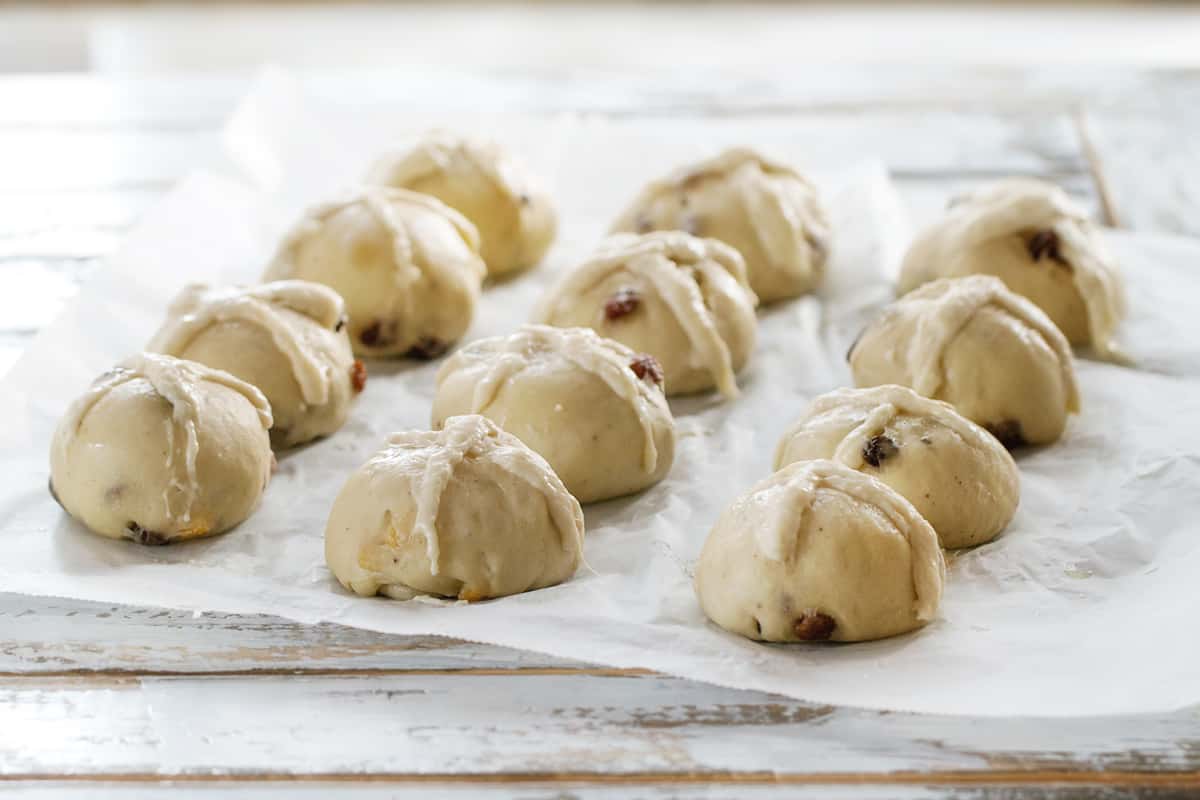
Bake the buns on the middle shelf for 15-20 minutes until they’re a deep golden brown and they sound hollow when you tap them on the bottom. Glaze the buns as soon as they come out of the oven while they’re hot.
Glazing Options
You have a few options for the glaze: 1) Make a glaze with 1/4 cup water and 1/4 sugar by placing the ingredients in a small saucepan, bring it to a boil, reduce the heat and simmer for 3 minutes, and brush it over the hot buns when they come out of the oven. 2) Heat 3 tablespoons of golden syrup in a small bowl in the microwave and brush it over the hot buns. 3) Gently melt some apricot jam in the microwave and brush it over the hot buns.
Let the buns cool.

Storage
As with most baked goods, these are best straight out of the oven. However they will keep for a couple of days and they’re also delicious cut in half and toasted.
How to Serve Hot Cross Buns
Serve the buns while they still slightly warm or cooled. Slice the buns and spread with butter, clotted cream, jam, or honey. Leftover buns are best sliced and toasted.
Enjoy!
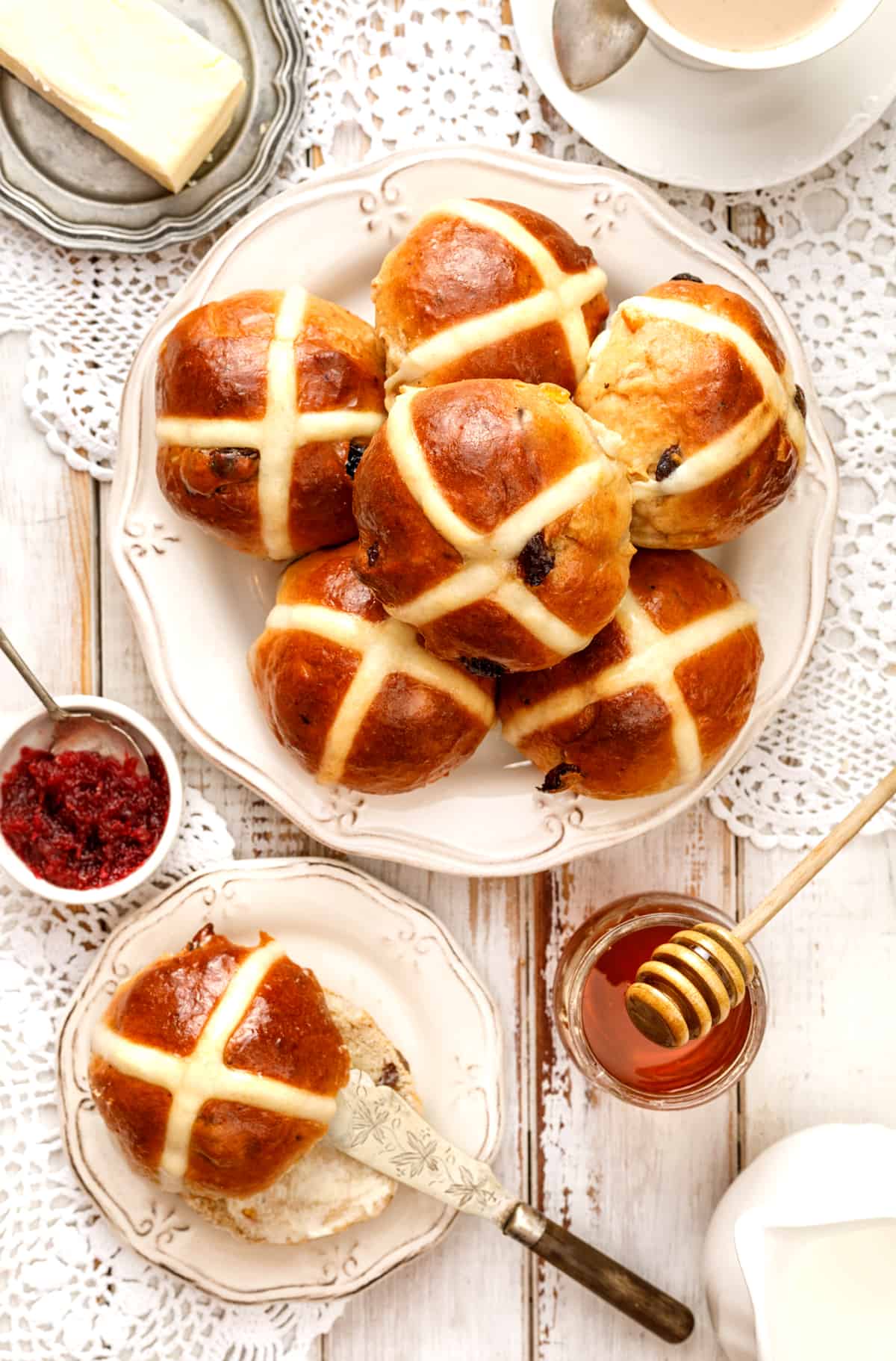
For more traditional British and Irish treats try my:
- Easter Biscuits
- Sticky Toffee Pudding
- Chelsea Buns
- Treacle Tart
- Rock Cakes
- Spotted Dick
- Lardy Cake
- Eccles Cakes
- Yorkshire Parkin
- Bara Brith (Welsh Tea Bread)
- Barmbrack (Irish Tea Bread)
- Mince Pie
- Lemon Curd
- Victoria Sponge Cake
Save This Recipe
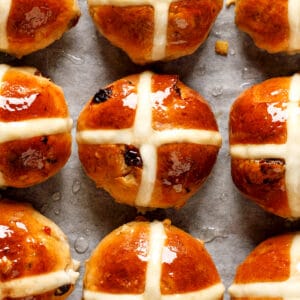
Traditional Hot Cross Buns
Ingredients
- 3/4 cup dried currants or raisins
- 1/4 cup diced candied orange and lemon peel (click link for recipe, **homemade STRONGLY recommended for the BEST ever flavor!)
- 1/4 cup hot black tea , can substitute apple juice
- 4 cups all-purpose flour
- 1/4 cup granulated sugar
- 2 teaspoons instant yeast
- 2 teaspoons mixed spice
- or Homemade Mixed Spice (click link for recipe, **homemade recommended for the best flavor!)
- 1 teaspoon ground cinnamon
- 1 teaspoon salt
- zest of one lemon
- 1 1/4 cups milk , room temperature
- 1/4 cup butter , room temperature
- 1 egg , room temperature
- 1 egg yolk , room temperature
Instructions
- Pour the hot tea or apple juice over the dried fruits, cover with plastic wrap, and let sit for about an hour until the fruit has absorbed the juices. This can be done well in advance such as the day ahead or overnight.
- Place the flour, sugar, yeast, spices, salt and lemon zest in the bowl of a stand mixer and stir to combine. Add the eggs, butter, and milk. Use the dough hook to knead the mixture into a smooth and elastic dough, about 5 minutes. Add the dried fruit and continue to knead the dough another 2 minutes or until the fruit is incorporated.Place the dough in a lightly greased bowl, cover loosely with plastic wrap and place it in a warm place to rise until doubled in size. I like to briefly heat the oven to 80-90 degrees F (not any hotter!), place the dough inside the oven, and close the door to rise. Rising time will vary depending on the temperature. Give it at least one hour but it might take closer to 2 hours.
- Punch down the dough and divide it into 12 equal pieces.For each piece into a ball and place it on a lined baking sheet. Cover loosely with plastic wrap and let them rise in a warm place for up to another hour until they're puffy and nearly doubled in size.Halfway into the rise preheat the oven to 400 degrees F.Baking Options:You can either place the buns closer together on the baking sheet so that once they're baked you'll need to pull them apart to separate them from each other and they will be more square-shaped. This is how they often come packaged in the store. Or you can space them farther apart so that you have distinctly separate and round buns (my personal preference).
- The next step is to pipe or place crosses on top of each bun.Piping Options: You have a few options for making the cross symbol on top: 1) Make a small batch of shortcrust pastry (follow this recipe for the shortcrust pastry), form it into thin strips and lay them in a cross pattern on top of the buns before baking. 2) Make a paste out of flour and water and pipe crosses on the buns (combine 1/4 cup flour with about 3 tablespoons of water to make a thick, gluey paste. Use more or less water as needed. Place the paste in a sandwich bag and cut off a corner of the bag to squeeze the paste into a cross shape onto the buns, or use a pastry bag.). 3) Make a sugar icing and pipe crosses on the buns after they're baked and cooled (combine 1 cup powdered/confectioner's sugar with 1/2 teaspoon vanilla extract and 3 teaspoons milk, give or take, to form a thick "pipeable" icing).Bake the buns on the middle shelf for 15-20 minutes until they're a deep golden brown and they sound hollow when you tap them on the bottom.
- Next glaze the buns as soon as they come out of the oven while they're hot.Glazing Options:You have a few options for the glaze: 1) Make a glaze with 1/4 cup water and 1/4 sugar by placing the ingredients in a small saucepan, bring it to a boil, reduce the heat and simmer for 3 minutes, and brush it over the hot buns when they come out of the oven. 2) Heat 3 tablespoons of golden syrup in a small bowl in the microwave and brush it over the hot buns. 3) Gently melt some apricot jam in the microwave and brush it over the hot buns.After glazing the buns let them cool.Serve the buns while they still slightly warm or cooled. Slice the buns and spread with butter, clotted cream, jam, or honey.These will keep in an airtight container for up to 2 days. Leftover buns are best eaten sliced and toasted.
Nutrition
Originally published on The Daring Gourmet March 16, 2023



















Do you use instant or quick rise yeast as one recipe requires the instant yeast to be added to the milk for ten minutes .
Hi Rosemary, this recipe calls for instant yeast which does not require being added to milk first.
This recipe, along with the homemade candied orange & lemon peels and homemade British spice mix, turned out PERFECTLY. I used to live across from the St Albans abbey and was missing these buns so badly. Nevermore, these are utterly delicious and an improvement over both the M&S version and the Abbey’s.
My main tip is to plan for a day-long project in making everything from scratch, grind your own spices for the mix, and pay close attention when proving the dough to stop it rising at just the right times. The recipe‘s times are a close guide, not an instruction. Also, check the expiration date on the yeast before starting.
Hi Julie, I am beyond thrilled to hear that and really appreciate the feedback, thank you so much!! <3
Would it be possible to make the dough and refrigerate it overnight. Raise it and bake it in the morning?
Yes you can, Jane, you can treat these the same way you would any yeasted rolls.
I made these last year and this Easter will be my second time. This is the best recipe I’ve found for hot cross buns, the flavor is unrivaled. I do take the time to make my own candied citrus peel and I agree that it’s a game changer. Can’t wait to make these again in a couple of weeks!
That’s wonderful, Renae, I’m so happy that these have become an Easter tradition in your home! Thank you very much for the positive feedback!
This recipe was easy to follow, has great tips and above all else makes delicious buns! I made mine dairy free and cane sugar free, substituted with Nuttelex, almond coconut milk and coconut sugar and they turned out great! (Not a fussy eater, dietary requirements!)
I’d love to make a chocolatey version though! Thinking with cocoa powder and dark choc chips? But was wondering what your thoughts on quantities and when to incorporate them into the recipe?
Thanks in advance!
Thank you so much, Liv, I’m thrilled that you enjoyed them and that you were able to make those substitutions with success! A chocolate version sounds lovely, especially coupled with the candied orange peel. I would aim for around 1/3 cup (35 grams) of cocoa powder and you’ll add it at the same time you add the flour. I would go with around 1 cup (200 g) of chocolate chips and add them at very beginning of Step 3: punch down the dough, knead the chocolate chips into the dough, then divide the dough and proceed as written.
I made these for Easter weekend and they are absolutely divine. I make your German stollen every Christmas and already know to trust your advice to make the homemade candied citrus peel so I made another batch of it for these hot cross buns and once again, SO worth it. I also made your recipe for the mixed spice. These sweet rolls have the softest, loveliest texture and the flavor is just heaven. And I agree with Margie about the apricot jam. I followed your option to add that as well and it makes these buns extra scrumptious. Thank you for adding a new Easter tradition to our family.
I’m so happy to hear that, Cori, and I appreciate your kind and generous feedback, thank you! <3
This is truly a special recipe! My favourite is the apricot glaze and the amazing soft texture of this bun. The spices are also just right. I added a bit orange juice with the grand marnier to soak the raisins and candied peel. Yum!!
I scored a cross in the buns but I think I wouldn’t do that next time, as the split opens up too wide for a neat cross on top. But honesty the apricot glaze makes the bun so beautiful and extra tasty! Best hot cross bun I have tasted and I have tasted many 😝
Oh Margie, I’m absolutely thrilled that you enjoyed them and appreciate the feedback so much, thank you! <3
Such a classic recipe for Easter! Turned out light, fluffy and delicious; my whole family loved them!
I’m so glad they were a hit, Sara, thank you for the feedback!